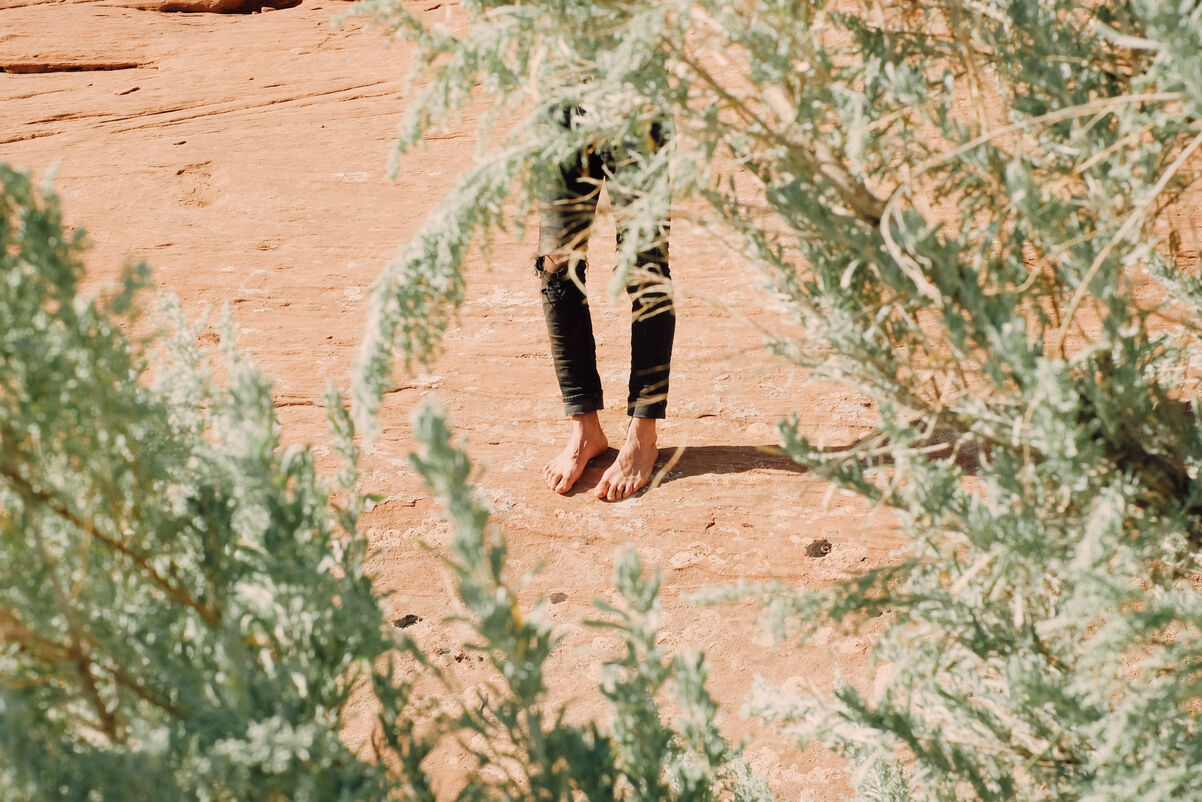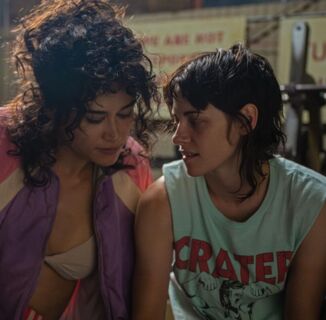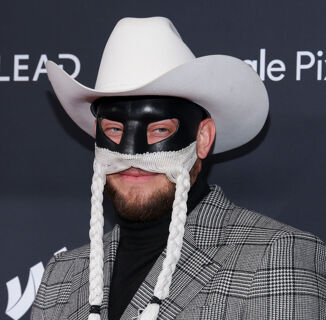On December 4th, 2017, President Donald Trump traveled to Salt Lake City to sign proclamations to shrink two national monuments by more than 2 million acres combined: Bears Ears National Monument and Grand Staircase-Escalante National Monument.
The monument’s shrinking will test new legal frontiers of public lands. This desert land has been cherished by many cultures for thousands of years. Here is my queer ode for it.
~~~

It is a curious landscape. One of mettlesome slickrock and meadowed summits. The kind of place where stands of pungent piñons brush their clean southwestern aroma over the hysterical geology. Introducing the wilderness of southern Utah. It is where one evening during moonrise, I yowled a secret at the beams silvering my nineteen-year-old self.
You see, I was among old friends voicing my discontent for my nature. Yes, the desert shrew was present, and the western pipistrelle was swooping blindly. There were ringtail cats (which are really just raccoons watching their figures), whipsnakes, plateau lizards, two juniper titmice, a great horned owl, and I assume a few white-throated swifts in the brush. Of course, to the north, there were the two mesas rising, as if the ground had decided to be a bear for Halloween and purchased a lackluster costume a headband with rounded ears.

There, in the red, cracked desert of the then BLM land, I had caterwauled a secret and I waited for a response. The sound of the constellations above. The sips of the sphinx moth licking the evening primrose. No response. And so, with a deep breath, I gathered the courage for a second, louder declamation. I began bravely with the first word, the airy contraction “I’m,” but lost my confidence during the opening “g” of the second word as the land midnighted, refusing congratulations or disappointment. Refusing any reaction at all.
I had hoped for a comforting deliverance from the landscape, forgetting its established stoicism from the eons of long-suffering mineral layers and indecisive seas. The only reassurance I received were the kangaroo rats leaving the littlest traces imaginable as they hopped into the evening. Me: baying next to quarrelsome cacti. Also me: hoping it really did get better.
~~~
On December 26, 2016, former President Barack Obama designated 1.35 million acres of this land as Bears Ears National Monument. The proclamation came after years of turmoil and disagreement between five Native American nations, ranchers, rural Westerners, environmental groups, oil extraction hopefuls, outdoor industry retailers, and energetic outdoor enthusiasts.
The decision was celebrated by the Bears Ears Inter-Tribal Coalition (composed of five local Native nations: Hopi Tribe, Navajo Nation, Ute Mountain Ute Tribe, Pueblo of Zuni, and Ute Indian Tribe) who put aside old differences and banded together alongside conservationist group Friends of Cedar Mesa.
Many saw Obama’s proclamation as a commencement for the U.S. government on the long, long, long, long, long road to redemption after its horrendous treatment of Native people since white settlement. And while the monument was welcomed warmly, it was nevertheless soured by Obama’s inaction during the protests of the Dakota Access Pipeline, in North Dakota, which were still taking place during the monument’s formal designation.

The controversial monument blankets the vermilion rocked mecca of southern Utah and cradles features like the San Juan River (which begins as snowmelt from the strapping San Juan mountains of southwest Colorado, running four hundred miles to its confluence at Glen Canyon with the Colorado River) to the 11,360 foot summit of Abajo Mountain in the Abajo range, known locally as The Blues.
Canyonlands National Park, comprised of its Castle in the Sky, Needles, and Maze districts, greets the monument at its northern terminus while the natural border of the San Juan River snakes its southern. Glen Canyon National Recreation Area draws the western border while the Manti-La Sal National forest west of the flaming 191 byway renders the eastern. Within the monument is the Dark Canyons Wilderness, Cedar Mesa, Comb Ridge, Valley of the Gods, the meandering yawns of the Goosenecks, as well as over 100,000 archaeological sites, some dating 13,000 years.
The Lime Ridge Clovis site contains an assemblage of nearly 300 lithic artifacts. Sharpened jasper called clovis points were the prominent remains found in the archaeological site: one of Utah’s oldest. It sits just south of Cedar Mesa, looking 360 degrees over ancient drainages. The Clovis people were a brave Paleo-Indian community who hunted and gathered megafauna (yes, wooly mammoths and land sloths) centuries ago.

Thousands of younger petroglyphs freckle the great expanse of the monument and are found many times by accident while hiking, canyoneering, backpacking, hunting, and climbing with the most well know being Newspaper Rock. The site is located near Indian Creek Recreation Area, a premier rock climbing destination known for its aesthetic cracks. The area attracts thousands of rock climbers from around the world.
The Windgate Rock Face in the valley features an astonishing collection of petroglyphs: pronghorn, buffalo, human figures, and patterns all outlined by natural black desert varnish. The markings were made by an assortment of cultures. Each one writing on the same wall. Everyone from the Anasazi, Archaic, Fremont, Navajo, and Pueblo communicated their existence across time.
Many of the petroglyphs feature the carefree flute man Kokopelli, one of southwestern mythology’s greatest venerations. Typically, the whimsical musician is featured in ithyphallic form (strutting a hard-on) as he wanders the rock faces with his humped back and sack of seeds. There are also reports of multiple ithyphallic figures in the same petroglyphs next to one another, aroused, side by side.

Connell O’Donovan, an administrator at UC Santa Cruz and a writer focusing on queer Mormon history, found a petroglyph twenty years ago while living in Moab. He describes the petroglyph as “two men with erections reaching out to embrace each other; it dates to circa 800 CE.” When O’Donovan later showed his friend Jose the photo of the petroglyph in town, his friend said, “No, no, they’re fighting!” O’Donovan told me he laughed and said, “Oh, is that what you call it, Jose?”
In recent years before the designation of the monument, looting became a problem as hundreds of sites were illegally robbed of their artifacts. Petroglyphs were also shot at with rifles and removed with rock saws. BLM officials have also documented instances of four-wheel drivers damaging 2,000-year-old sites and burning ancient Navajo hogans. During a 2009 sting operation by the FBI, 24 vandals were indicted for stealing and selling over 40,000 artifacts from the land.
On a set of Sand Island petroglyphs, vandals scribbled “1963,”, “John,”, and “Custer died for your sins” over a collection of Kokopellis.
~~~
Growing up a hop, skip, and a jump from the Southwest proper, the little musical deity, Kokopelli, found his way to me, grooving northward into the ponderosa stands of my upbringing. Even on the Front Range of Colorado, he was the cast iron book ends on the living room shelf of our log home.

I saw him in craft stores, on t-shirts sold at our local outdoor retailer, and at the Manitou Cliff Dwellings, a set of relocated Anasazi ruins, a tourist attraction which named its cafe after the deity. Although he took exaggerated, stylized, and reimagined forms, he always carried the same contagious moxie.
It is hard not to smile when you see Kokopelli. His elastic posture, his feathered mohawk, and the flute.
It is said that you can softly hear the flute as the ground absorbs snowdrifts for flowers, for Kokopelli is the bringer of spring. His sack is full of wildflower seeds which he tosses liberally and flamboyantly. Ah, spring! The warm chinooks and the yuccas erupting soft white petals from sharp thin spears. Hope. The feminine. Love. Growth, too. He brought fertility, gathered turquoise, blessed the good harvest, and, apparently, his penis could also detach and float down rivers. What a trickster!
Like Antiquity’s Dionysius, Kokopelli is eternally nomadic. Never staying for long, he is as brief as your most cherished season. He is as charismatic as your high school crush. It’s never easy to forget a Kokopelli: a bigger than life personality, a happy-go-lucky mentality, and a seductive playboy. Although he was the bringer of fertility, I can’t help but wonder about the two Kokopelli-like figures alone on the rock panel, proudly sporting their arousal to one another.

~~~
This summer, just shy of the solstice, I visited Bears Ears after the review announcement that cast uncertainty over the landscape. I was hoping to offer the landscape some comfort, at the very least, to thank it for the many memories I had made visiting it many times in college for I was worried I may not see it like it was, ever again.
Blanding and Monticello (two towns that neighbor Bears Ears) antagonized the monument with billboards that read “#RescindBearEars,” while bumper stickers reading “#NoMonument” were smacked on cars.
Although the largest county in the state, San Juan county remains the poorest. Many white residents of the community expressed dissatisfaction for the monument for their inability to access the land that they viewed as their backyard. Drillers were denied permits, hunters and four-wheel drivers had to obtain permits for recreation. But the biggest concern was the understandable fear of job loss without any opportunities for resource extraction, even though much of the land was already federally owned BLM land.
And so, a neo-sagebrush rebellion ignited and divided residents of the community into two sides: for the monument or against it. The fire was stoked by ideas of “federal overreach” and “land grabbing.” Fuel was added to the anti-conservation movement by Senator Orrin Hatch, who actively ignored and discredited Native voices over a press conference during the monument’s review. “The Indians,” he said, “they don’t fully understand that a lot of things that they currently take for granted on those lands, they won’t be able to do if it’s made clearly into a wilderness or monument.”

Much like Hatch, President Trump demeaned Native Americans in November, by racially slurring “Pocahontas,” his nickname for Senator Elizabeth Warren, while paying tribute to Navajo Code Talkers in front of a portrait of Andrew Jackson.
And Trump’s Secretary of the Interior, Montanan Ryan Zinke, has also made comments dismissing his former political opponent for 2016’s U.S. House seat, Denise Juneau, an openly gay Native woman.
Zinke said to her during a debate for the seat that it was fine “if you want to be a lesbian.”

At the end of the monument short review period, which looked at 27 monuments across the country, Zinke also brazenly said that the 2.8 million public comments (~98%) that were in support of the keeping the monuments as is, are the result of “a well-orchestrated national campaign organized by multiple organizations” erasing the voice of millions who participated in the review process. He added, without evidence, that locals near the monument “lack the organization, funding, and institutional support to compete with well-funded (environmental groups)”
There was also the forgotten controversy with the Rainbow Flag, where the National Parks Service had approved of plans to fly the flag at New York City’s Stonewall Monument under federal flags. The event would have been the first time in the country’s history that the Rainbow Flag would be welcomed on federal land. But a day before the October 2017 ceremony, the National Parks Service suddenly withdrew their previous support.
While the event went forward without the organization’s support, many at the rally felt the move reduced queer Americans to second-class citizens.
~~~
When the sunset scorched the rocks during the golden hours of my last afternoon in the monument this past summer, it was as if the land of southern Utah was asking for pardoning. I saw shrubs pleading on the precipice of the Valley of the Gods canyon rims. I saw a Cooper’s hawk in the sky, circling over and over again, memorizing the land in case it was to change. Of course, I was empathetic to the opuntia, which forfeited its blood-red blooms.
The light stretched into the night only a few days after the solstice. With the generous daylight I was given, I went for a walk from my campsite, on a little path in the direction of the grand buttes. Crooning my own little desert tune through the topography of rocks shrugged from the high cliffs, the cactus snarls, and coarse grass clustered.

And as I hummed, I thought of my moonlit self, five years before on one of my first trips to the land. The time I bayed my existence only for it to skim across the slick rock and be swallowed by the canyons and forgotten. Then, before me, I came across a small wall of petroglyphs full of Kokopellis.
We are lucky to wander the stunning expanse of landscapes. Too often we forget the safest spaces are not the gayborhoods of our sprawling metropolises. For our refuge has always been our naturalness and our freedom from claustrophobic, oppressive eyes.
It is why we have hidden in literature as naturalists blessing all bodies and forms and beings. Our safe space is the sand desert, the slot canyons, the cathedral towers, the sandbars in the middle of the river, and the hot springs beneath the spruce of the alpine. It is all of our monuments, wilderness, parks, and forests. Our queerness originates from our naturalness but only is it blessed by our landscapes.
Our queerness is written in stone.
Photography by: Alec McKeand, Amongthepine.com
Help make sure LGBTQ+ stories are being told...
We can't rely on mainstream media to tell our stories. That's why we don't lock our articles behind a paywall. Will you support our mission with a contribution today?
Cancel anytime · Proudly LGBTQ+ owned and operated
Read More in Culture
The Latest on INTO
Subscribe to get a twice-weekly dose of queer news, updates, and insights from the INTO team.
in Your Inbox














